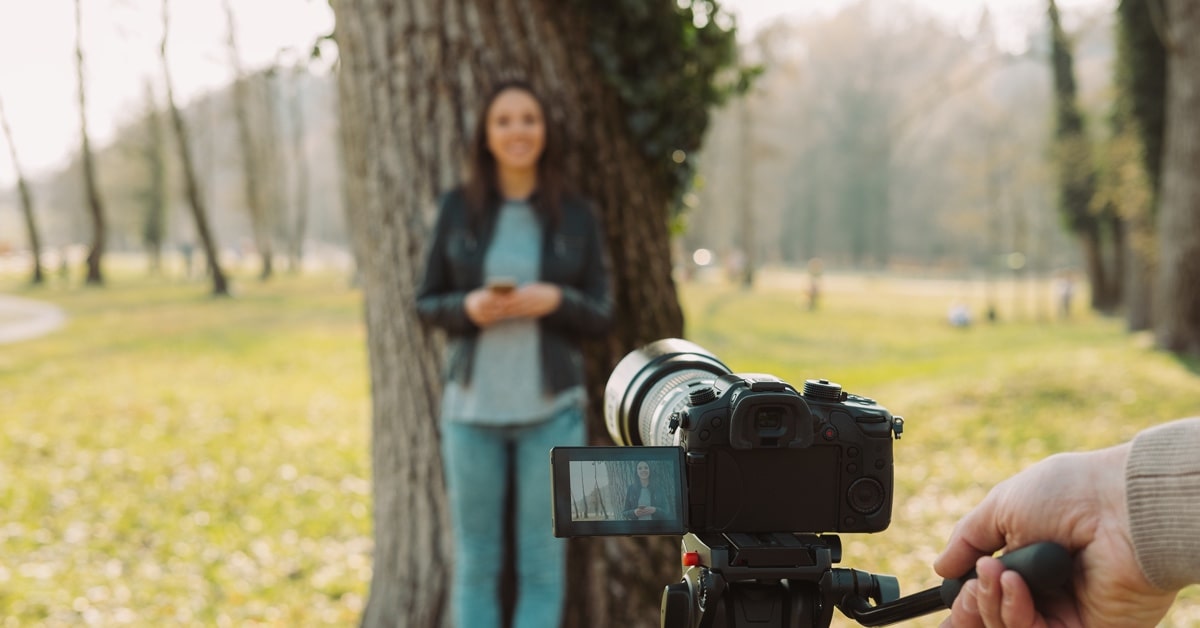
When it comes to social media, still images are no longer going to be a driving force. By the end of 2022, experts predict that videos will drive over 82% of all Internet traffic—a figure that’s too big to ignore.
If you’ve never made a video or haven’t had the time to figure out your video strategy, don’t worry, we’ve got you. Here are our best tips for making social media videos for your course that meet or exceed your marketing goals.
Build a video content strategy
Track the success of your videos
Level up your social media channels
Plan your next few months of social media content in advance with our free downloadable marketing plan templates.
How to build a video content strategy
The good news is, you don’t need to be an experienced movie producer to create great video content, nor do you need an expensive piece of software. Here are the steps we recommend taking to build a solid video strategy, regardless of budget or experience.
Identify ideas and trends
Before you start filming, you’ll need to brainstorm ideas for what you want to create. You can use your own imagination or take a look at trending topics. You can consult trend data from Google Trends or Pinterest Trends, or scroll through the Discover page on TikTok or the Explore page on Instagram. Doing so will give you a better idea of what’s popular, so that you can make videos that align with current interests.
Come up with clear objectives
Before you start filming and posting, think about what you’re looking to accomplish by posting videos. Are you looking to raise awareness? Get more bookings? Both? Knowing these objectives ahead of time will help you make content that not only looks and sounds great, but that supports your greater goals.
Check your competitors
Before you start creating your own content, it’s a good idea to see what your competitors are posting to understand how they’re using video content (or if they’re even using it at all). Seeing what similar courses or even other activities in your area are doing with video will help you better understand how to cut through the noise.
Create content
Now that you have ideas, objectives and competitor analyses out of the way, it’s time to create content. You can film entirely new videos just for social media, or, if you have any footage on hand from previous projects, you can repurpose it.
You don’t need to own a special camera to make a high quality video—most phone cameras nowadays will do the job just fine. However, we do recommend investing in video editing apps or software. InShot, iMovie, and Splice are popular options.
How to optimize your social media videos
When creating and editing your videos, give them the best chance at performing well by optimizing them. Follow these four guidelines to set your content up for success.
- Take up as much space on the screen as possible
Certain platforms give you the option to post videos in a 9:16, 1:1, 1:91 or 4:5 ratio. While it’s tempting to post horizontal videos, when the platform allows for vertical video, you should opt to take up as much of the screen as possible. Vertical videos take up to 78 percent more space on a person’s feed and data shows that they usually outperform landscape videos.
- Have a clear call-to-action
There should always be an objective behind your videos. This could be anything from encouraging viewers to visit your website or follow your account. Whatever it is, make sure it’s clear and easy to understand. That way, people will be more likely to follow through with it.
- Keep it an appropriate length
As a general rule, shorter is better. If you can’t get your message across quickly enough, they will skip your video and keep scrolling.
However, you may find that your audience does actually tune into longer videos. If that’s the case, make them the optimal length for your audience’s enjoyment.
- Show your branding sooner rather than later
Studies by Facebook show that when a brand is mentioned within the first 3 seconds of the video, it significantly increases aided recall. If your main marketing goals are brand recognition and awareness, make sure to capitalize on this opportunity.
Track the success of your videos
Once you’ve posted your video content, track its performance to see how it stacks up to your objectives. Here are some KPIs you should track and look out for:
View count: How many people watched your video? Note that view count doesn’t take retention into account. On Instagram, for example, a view is counted after someone watches your video for at least three seconds.
Likes: Most social media platforms let users like content. Compare this with your views and comments to get a better understanding of how users are engaging with your content.
Shares: Sharing is a powerful way to get more eyeballs on your content. Pay attention to how many shares you receive to figure out if your content is being spread organically thanks to your audience.
Comments: Comments can help you gauge how your audience feels about the content you’ve created. If you mostly positive comments, it’s a sign that your audience is liking what you’re producing. Negative comments may mean you need to reconsider your strategy or tone.
Average watch time: Your watch time can give you insight as to whether or not your content was engaging enough to watch in its entirety. For instance, if your video is one minute long, but your average watch time is only 20 seconds, you might consider making your future videos shorter or more engaging beyond the 20 second mark.
Reach: How many people saw your video in their feeds, Explore pages or For You pages? Compare this number to your view count to get a sense of the percentage of people who see your videos in-feed and decide to keep watching.
Audience demographics: See what kinds of people are watching your videos, such as where they live (are they local or out-of-towners?) and their age range (are they millennials or boomers?). Use this information to craft content that’s even more relevant to who you’re reaching.
Test and iterate
Social media is constantly changing. This means that your best-performing content right now might not be your best-performing content in the future.
For that reason, we strongly recommend you iterate on your most successful content, but that you also experiment with new formats or ideas in tandem. When it comes to social media, you can never be sure that something will be a flop or go viral until you hit “publish.”
For video ad content, also known as sponsored content, you can A/B test different versions of the same ad until you find the optimal result. For organic content, paying attention to trends, your metrics and your audience’s preferences and habits will be your best bet in terms of testing concepts new and old.
Social media marketing videos made easy
When you take into account all of the steps listed here, creating social media videos can evolve into a full-time responsibility. It doesn’t have to be, though, thanks to Lightspeed Golf’s digital marketing services.
If you’re looking for help, contact our golf experts to learn more about full service marketing, digital tee sheet, POS, and payment processing services for courses like yours.

News you care about. Tips you can use.
Everything your business needs to grow, delivered straight to your inbox.



